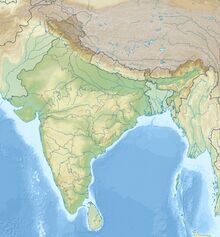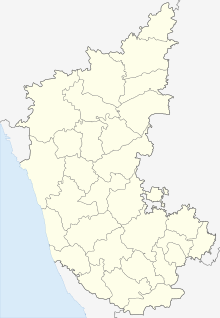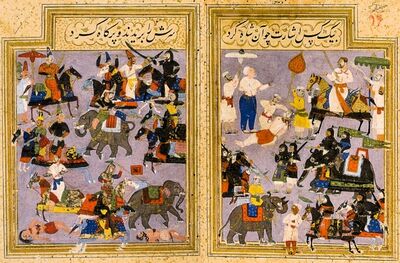معركة تاليكوتا
| معركة تاليكوتا Battle of Talikota | |||||||
|---|---|---|---|---|---|---|---|
| جزء من Muslim conquest in the Indian subcontinent | |||||||
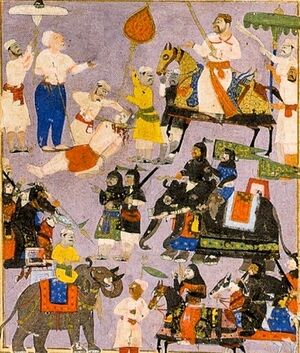 معركة تاليكوتا. Husain Shah (riding a horse) orders the decapitation of Ramaraya (reigned 1542-65), the defeated ruler of Vijaianagara. تعريف حسين شاهي (Chronicle of Husain Shah), 16th century | |||||||
| |||||||
| المتحاربون | |||||||
| امبراطورية ڤيجايانگرا | |||||||
| القادة والزعماء | |||||||
|
| |||||||
الموقع داخل الهند | |||||||
معركة تاليكوتا (23 يناير 1565) was a watershed battle held between the امبراطورية ڤيجايانگرا وتحالف سلطنات الدكن.[2] The defeat of Aliya Rama Raya led to the eventual collapse of the polity and reconfigured Deccan politics.[2]
The specific details of the battle and its immediate aftermath are notoriously difficult to reconstruct in light of the distinctly contrarian narratives present across primary sources.[3] Defeat is usually blamed on the gap in relative military prowess.[4][3] Orientalist and nationalist historians asserted of the battle to be a civilization clash between Hindus and Muslims;[2][3] this view has since penetrated into the Hindutva discourse.[5] Contemporary scholars reject such characterizations as flawed.[5][6]
الخلفية
Rama Raya, after his installation of a patrimonial state and emerging as the ruler, adopted a political strategy of benefiting from the internecine warfare among the multiple successors of the Bahmani Sultanate, and it worked well for about twenty years of his reign.[2][7][8]
However, after a series of aggressive efforts to maintain hold over Kalyan[9][أ] and diplomatic dealings with the Sultanates laden with insulting gestures, the four Muslim Sultanates—Hussain Nizam Shah I and Ali Adil Shah I of Ahmadnagar and Bijapur to the west, Ali Barid Shah I of Bidar in the center, and Ibrahim Quli Qutb Shah Wali of Golkonda to the east—united in the wake of shrewd marital diplomacy and convened to attack Aliya Rama Raya, in late January 1565.[2][3]
المعركة
المصادر
There exist multiple contemporary chronicles (literary as well as historical) documenting the war:[3][10]
- Burhan-i Maasir by Sayyid Ali Bin Abdullah Tabataba, the court historian of Ahmadnagar Sultanate.
- Gulshan-i Ibrahimi by Ferishta, the court historian of Bijapur Sultanate.
- Taḏkerat al-molūk by Rafi-ud-Din Shirazi, another court historian of Bijapur Sultanate.
- Décadas da Ásia by official Portuguese record-keeper Diogo do Couto.
- Letters by Goa governor Dom Antão de Noronha.
- Fath-Nama-i Nizam Shah by Hasan Shauqi, a Dakhni poet.
- Tarif-i Husayn Shah by Aftabi, a poet at Ahmadnagar court.
The details of the battle and immediate aftermath are often distinctly contrarian and even accounting for biases, reconstruction is difficult, if not impossible.[3][11][12]
الوصف
The exact venue of clash has been variously mentioned as Talikota, Rakkasagi-Tangadigi and Bannihatti—all on the banks of river Krishna.[3][13][ب] There exists debate as to the precise dates.[3][14]
Span-lengths vary from hours to days; descriptions of battle formations and maneuvers vary too.[3]
النتائج
Rama Raya was eventually beheaded by Sultan Nizam Hussain himself or on his behest despite Adil Shah, who had friendly relations with Raya, intending against.[3] In the resultant confusion and havoc, Rama Raya’s brother Tirumala deserted with the entire army and tried to regroup in Vijaynagara but failed; thereafter, he moved to the outskirts.[2][8] His other brother Venkatadri was blinded and likely, killed in action.[2]
الأعقاب
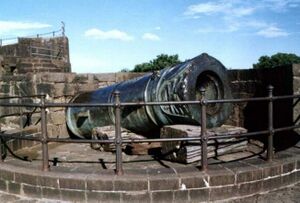
The Sultanates' armies went on to plunder Vijayanagara, unopposed.[2] Popular accounts and older scholarship describe Vijayanagara falling to ruins, in light of the widespread desecration of sacred topography; however, this view has been contested.[16] Contemporary historians and archaeologists warn against conflating the state with the town as little evidence exists about any damage inflicted beyond the Royal Center; they further emphasize about the politically strategic nature of destruction and arson, since sites associated with sovereignty, royal power, and authority were subject to more wanton means.[16]
Nonetheless, the battle caused a political rupture for the state of Vijayanagara and permanently reconfigured Deccan politics.[2] Patronage of monuments and temples ceased, the Vaishnava cult perished, and the Royal Center was never rebuilt.[2][17] The Bijapur Sultanate reaped maximum gains but their alliance did not last long.[8][18] Tirumala went on to establish the Aravidu dynasty, which held sway over fragments of the erstwhile empire and even operated out of Vijayanagara for two years, before shifting to Penugonda.[8][18] But faced with successional disputes, rebellions by multiple local chieftains—primarily Telugu Nayak houses—who did not wish for the reemergence of any central authority,[ت] and continuous conflicts with the Bijapur Sultanate—who might have been invited by Rama Raya's son—, it moved southwards before disintegrating in the late 1640s.[2][3][8][20]
الذكرى
تحليل الهزيمة
Vijayanagara side was winning the war, state Hermann Kulke and Dietmar Rothermund in a survey of Indian history, until two Muslim generals of the Vijayanagara army switched sides.[7][21] Many scholars, however, reject this account of treachery as a post-battle speculation by Venetian merchant Cesare de Federici in Viaggi, which would be taken up by a section of nationalist historians in their quest to identify traitors upon whom the responsibility of any and all Hindu defeats can be entrusted; a gulf of difference in military prowess—primarily stemming from a failure to incorporate gunpowder technology—is instead noted as the primary factor.[3][4][5][11]
صدام الحضارات
Colonial era historians (Robert Sewell, Jonathan Scott et al) drawing from the accounts of Firishta and later, nationalist historians (Aluru Venkata Rao, B. A. Saletore, S. Krishnaswami Aiyangar, K. A. Nilakanta Sastri et al) lensed the battle as a Clash of Civilizations wherein the "Ramrajya" of Vijayanagara, a "Hindu bulwark" state fell to "Muhammedan" conquests driven by religious bigotry.[2][3][5][16][22][23][24]
Richard M. Eaton rejects that there were any religious motives behind the battle and described of the civilization hypothesis as orientalist scholarship, which ignored the multiple alliances of Rama Raya with different Muslim rulers at different spans of time (in tune to his political strategy), the thorough perfusion of Persian Islamate culture with Vijaynagara Kingdom, as evident from court-sanctioned art, architecture and culture, and strategic alliances of Rama Raya's heirs (Aravidus) with heirs of the Deccan Sultans.[2][4] Romila Thapar, Burton Stein, Sanjay Subrahmanyam, Muzaffar Alam, Stewart N. Gordon and other scholars agree on the basis of similar analyses; additional arguments include that the Berar Sultanate did not join the battle and that the Sultanate-alliance dissipated soon enough.[29] Harmonious Hindu-Muslim relations in the empire has been documented and there were high-placed Muslims in Vijaynagara Court.[32]
A report in Frontline states that this debunked argument has been weaponized by the Hindu nationalist right in its bid to demonize (and other) the Muslim in contemporary India.[5]
في الثقافة الشعبية
The battle has been adopted into a play by Girish Karnad, who based it on Eaton's analysis.[33][34]
ملاحظات
- ^ Kalyana was the capital of the Chalukyas. Rama Raya sought to control the territory in his bid to gain popular legitimacy by establishing himself as the true heir to Chalukya sovereignty and glory. Other examples included retrofitting of decayed Chalukya complexes and bringing back Chalukya festivals.
- ^ James Campbell had reported traces of the Vijayanagara defensive fortifications along the southern bank of Krishna in these regions as late as 1884.
- ^ Stein notes of these independent estates to have been consolidating power since the zenith of Rama Raya's rule. He considers the entire span of Vijayanagara Empire to be a weakly-centralised polity, whose most important territories were regarded by local chiefs as independent "in every respect save that they could not claim to be fully-fledged kingdoms". Noboru Karashima disagrees with Stein's broad characterization but agrees that the final period of the Vijayanagar empire (Aravidus) was indeed marked by the growing power of the Nayakas as local feudal lords.[19]
المراجع
- ^ Sastri, K A Nilakanta, ed., The battle of Rakshasi Tengadi, pp. 263-264, https://archive.org/details/K.A.NilakantaSastriBooks/K.%20A.%20Nilakanta%20Sastri/Further%20Source%20Of%20Vijayanagara%20History%20Vol%20I%201946%20/page/n278/mode/1up
- ^ أ ب ت ث ج ح خ د ذ ر ز س ش Eaton, Richard M., ed. (2005), Rama Raya (1484–1565): élite mobility in a Persianized world, The New Cambridge History of India, Cambridge: Cambridge University Press, pp. 78–104, doi:, ISBN 978-0-521-25484-7, https://www.cambridge.org/core/books/social-history-of-the-deccan-13001761/rama-raya-14841565-elite-mobility-in-a-persianized-world/EABCC41A5AAFC5E0672C759AB59C053A, retrieved on 2020-12-08
- ^ أ ب ت ث ج ح خ د ذ ر ز س ش ص Subrahmanyam, Sanjay (2012-04-12). "Courtly Insults". Courtly Encounters : Translating Courtliness and Violence in Early Modern Eurasia (in الإنجليزية). Harvard University Press. pp. 34–102. doi:10.4159/harvard.9780674067363.c2. ISBN 978-0-674-06736-3.
- ^ أ ب ت Eaton, Richard M. (2019). India in the Persianate Age : 1000–1765. University of California Press. ISBN 9780520325128.
- ^ أ ب ت ث ج Ahmed Sayeed, Vikhar (18 January 2019). "Battle of Talikota: Beyond the Hindu-Muslim binary". Frontline (in الإنجليزية). Retrieved 2020-12-09.
- ^ أ ب Ramachandran, Nandini. "Histories that challenge the reductionist popular understanding of Islam in India". The Caravan (in الإنجليزية). Retrieved 2020-12-09.
- ^ أ ب Kulke, Hermann; Rothermund, Dietmar (2016-05-27). A History of India (in الإنجليزية). Routledge. pp. 145–6. doi:10.4324/9781315628806. ISBN 978-1-315-62880-6.
- ^ أ ب ت ث ج ح Stein, Burton, ed. (1990), Imperial collapse and aftermath: 1542–1700, The New Cambridge History of India, Cambridge: Cambridge University Press, pp. 109–139, doi:, ISBN 978-0-521-61925-7, https://www.cambridge.org/core/books/new-cambridge-history-of-india/imperial-collapse-and-aftermath-15421700/FED92D618E0134EA9B154C696D64A008, retrieved on 2020-12-08
- ^ Shobhi, Prithvi Datta Chandra (2016-01-02). "Kalyāṇa is Wrecked: The Remaking of a Medieval Capital in Popular Imagination". South Asian Studies. 32 (1): 90–98. doi:10.1080/02666030.2016.1182327. ISSN 0266-6030.
- ^ Gordon, Stewart (2016-01-02). "In the Aura of the King: Trans-Asian, Trans-Regional, and Deccani Royal Symbolism". South Asian Studies. 32 (1): 42–53. doi:10.1080/02666030.2016.1174429. ISSN 0266-6030. S2CID 164169912.
- ^ أ ب ت ث Ray, Aniruddha (2003). "The Rise and Fall of Vijayanagar – an Alternative Hypothesis to "Hindu Nationalism" Thesis". Proceedings of the Indian History Congress. 64: 420–433. ISSN 2249-1937. JSTOR 44145480.
- ^ Guha, Sumit (2015-07-09). "Rethinking the Economy of Mughal India: Lateral Perspectives". Journal of the Economic and Social History of the Orient (in الإنجليزية). 58 (4): 546. doi:10.1163/15685209-12341382. ISSN 1568-5209. JSTOR 43919254.
- ^ "The Site of the so-called Battle of Talikota – ProQuest". search.proquest.com (in الإنجليزية). Retrieved 2020-12-09.
- ^ Sarkar, Jadunath (1960). Military History of India. M. C. SARKAR AND SONS PRIVATE LTD. KOLKATA. p. 91.
- ^
 Chisholm, Hugh, ed. (1911). . دائرة المعارف البريطانية. Vol. 3 (eleventh ed.). Cambridge University Press. p. 927.
Chisholm, Hugh, ed. (1911). . دائرة المعارف البريطانية. Vol. 3 (eleventh ed.). Cambridge University Press. p. 927. {{cite encyclopedia}}: Cite has empty unknown parameter:|coauthors=(help) - ^ أ ب ت ث Lycett, Mark T.; Morrison, Kathleen D. (2013-01-01). "The "Fall" of Vijayanagara Reconsidered: Political Destruction and Historical Construction in South Indian History". Journal of the Economic and Social History of the Orient (in الإنجليزية). 56 (3): 433–470. doi:10.1163/15685209-12341314. ISSN 1568-5209. JSTOR 43303558.
- ^ Verghese, Anila (2004-09-01). "Deities, cults and kings at Vijayanagara". World Archaeology. 36 (3): 416–431. doi:10.1080/1468936042000282726812a. ISSN 0043-8243. S2CID 162319660.
- ^ أ ب Eaton, Richard Maxwell; Wagoner, Phillip B. (2017-09-18). Power, Memory, Architecture (in الإنجليزية). Oxford University Press. ISBN 978-0-19-947769-2.
- ^ Chakravarti, Ananya (2012). The empire of apostles: Jesuits in Brazil and India, 16th–17th c (Thesis) (in الإنجليزية). University of Chicago. ProQuest 1040866864.
- ^ Talbot, Cynthia (2001). "The Kakatiyas in Telugu Historical Memory". Precolonial India in Practice: Society, Region, and Identity in Medieval Andhra. Oxford University Press. p. 196. doi:10.1093/0195136616.001.0001. ISBN 9780195136616.
- ^ K. A. Nilakanta Sastri (1955), A History of South India, Oxford University Press, p. 267, ISBN 0195606868
- ^ Nair, Janaki (1996). "'Memories of Underdevelopment' Language and Its Identities in Contemporary Karnataka". Economic and Political Weekly. 31 (41/42): 2809–2816. ISSN 0012-9976. JSTOR 4404683.
- ^ أ ب Archambault, Hannah Lord (2018). Geographies of Influence: Two Afghan Military Households in 17th and 18th Century South India (Thesis) (in الإنجليزية). UC Berkeley.
- ^ أ ب Shekhar, Shashank (25 October 2019). "Hampi: Ruins of splendour". Frontline (in الإنجليزية). Retrieved 2020-12-09.
- ^ Eaton, Richard M. (2016-01-02). "Afterword". South Asian Studies. 32 (1): 126–128. doi:10.1080/02666030.2016.1201895. ISSN 0266-6030. S2CID 219698039.
- ^ Gordon, Stewart (2016-01-02). "In the Aura of the King: Trans-Asian, Trans-Regional, and Deccani Royal Symbolism". South Asian Studies. 32 (1): 42–53. doi:10.1080/02666030.2016.1174429. ISSN 0266-6030. S2CID 164169912.
- ^ Roy, Kaushik, ed. (2012), Hindu Militarism under Islamic Rule: 900–1800 ce, Cambridge: Cambridge University Press, pp. 161–210, ISBN 978-1-107-01736-8, https://www.cambridge.org/core/books/hinduism-and-the-ethics-of-warfare-in-south-asia/hindu-militarism-under-islamic-rule/2D9871D67B39CA75FE7BF76F9767B85B, retrieved on 2020-12-09
- ^ Wagoner, Phillip B. (1996). ""Sultan among Hindu Kings": Dress, Titles, and the Islamicization of Hindu Culture at Vijayanagara". The Journal of Asian Studies. 55 (4): 851–880. doi:10.2307/2646526. ISSN 0021-9118. JSTOR 2646526.
- ^ [8][11][25][26][23][27][6][24][28]
- ^ Shivarudraswamy, S.N. (2005). "Hindu-Muslim Relations Under the Vijayanagara Empire". Proceedings of the Indian History Congress. 66: 394–398. ISSN 2249-1937. JSTOR 44145855.
- ^ Verghese, Anila (1995). Religious traditions at Vijayanagara, as revealed through its monuments. Vijayanagara research project monograph series. New Delhi: Manohar : American Institute of Indian Studies. ISBN 978-81-7304-086-3.
- ^ [30][11][3][16][31]
- ^ "History vs 'Crossing to talikota' play by Girish Karnad". Firstpost. 21 October 2019. Retrieved 2019-11-01.
- ^ Guha, Sumit (2009). "The Frontiers of Memory: What the Marathas Remembered of Vijayanagara". Modern Asian Studies. 43 (1): 269–288. doi:10.1017/S0026749X07003307. ISSN 0026-749X. JSTOR 20488079. S2CID 145476823.
